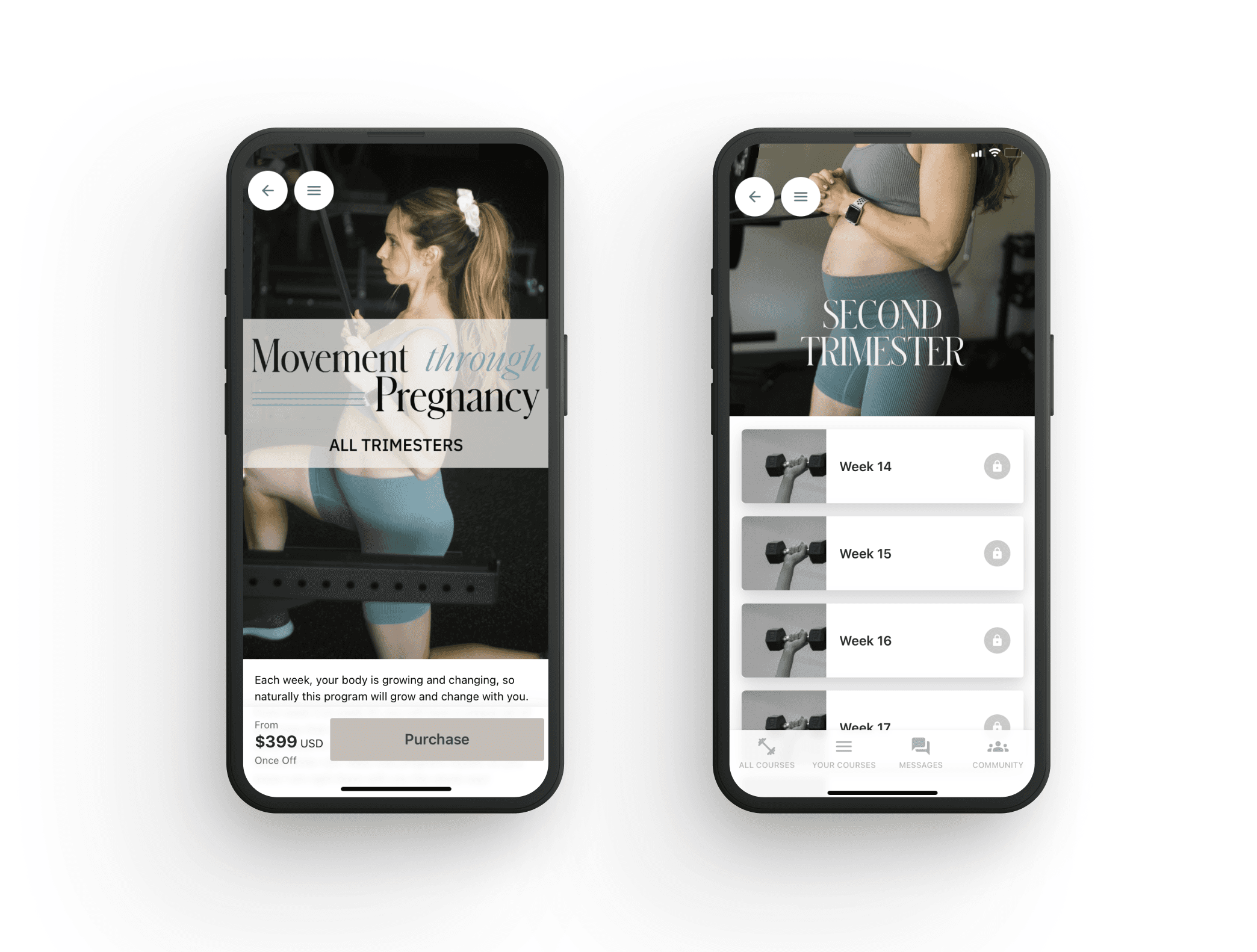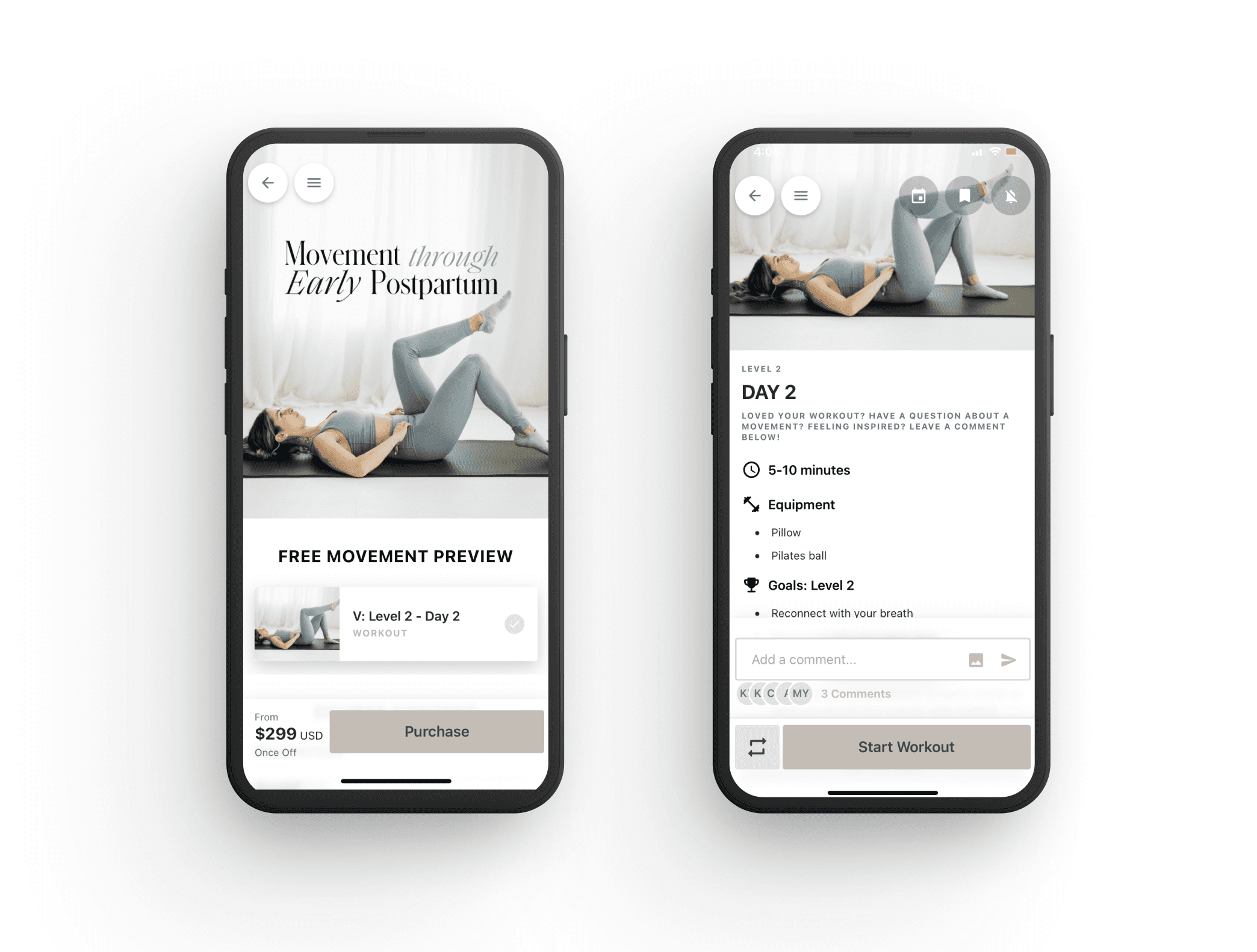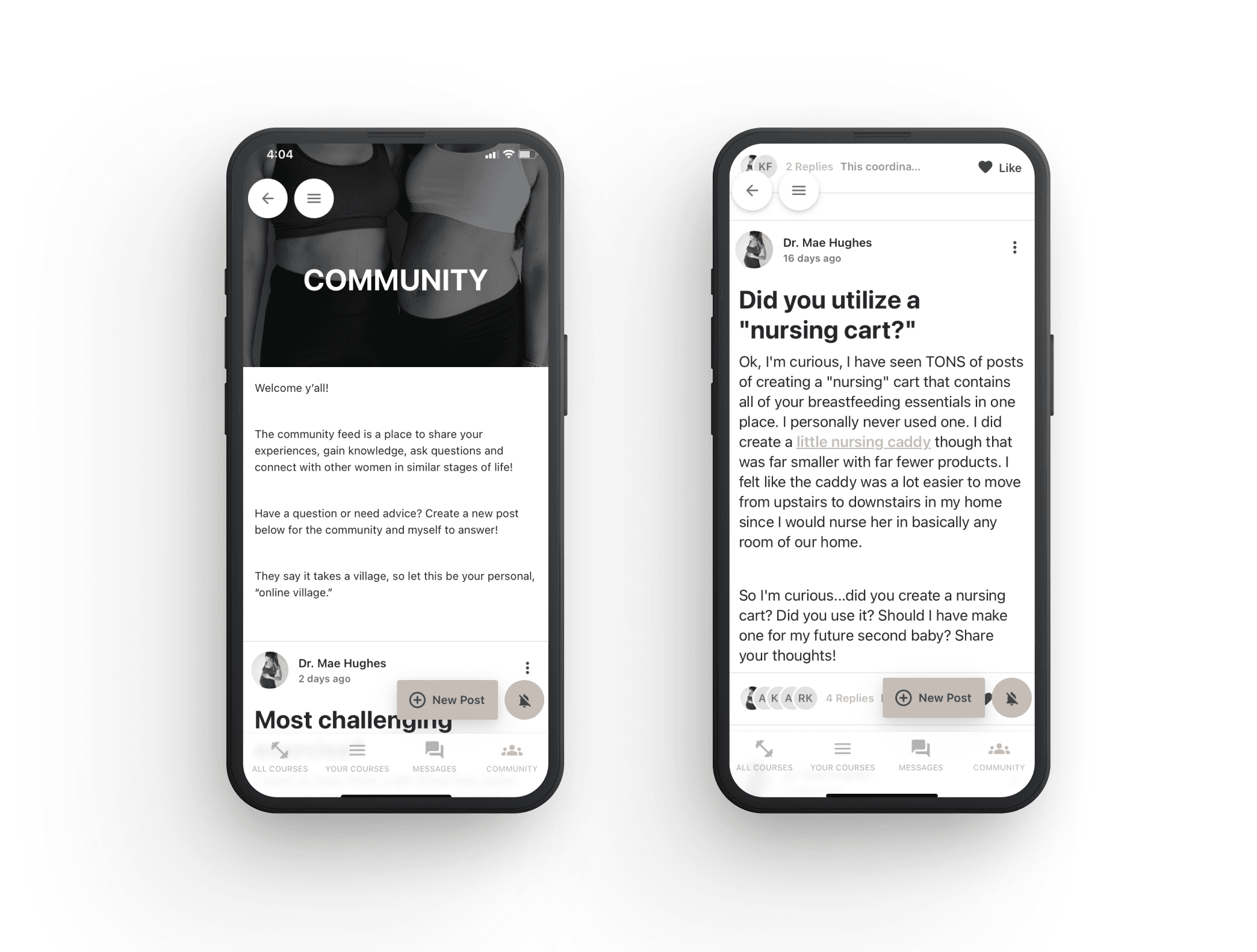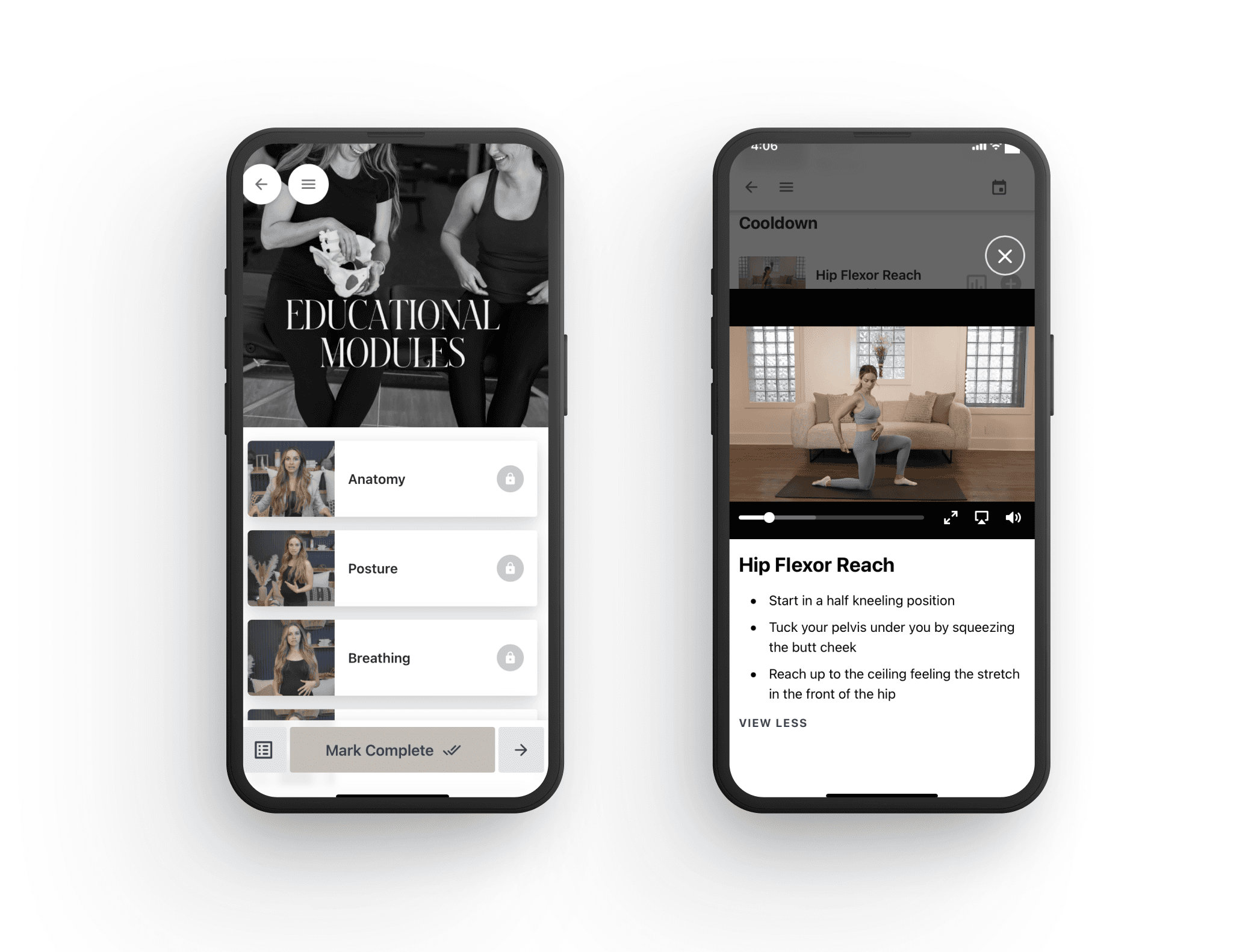Made with Movement
How Dr. Mae Hughes is Bridging the Gap in Pre & Postnatal Healthcare with her own app

Monica McCormick
14 min
·
Jul 28, 2023
In the healthcare world, we are fortunate to encounter those who redefine the way we approach wellness and ignite a true sense of empowerment. Dr. Mae Hughes, a pelvic floor specialist and physical therapist based out of Nashville, Tennessee, is a shining example of this sort of visionary. With a deep commitment to comprehensive care and a passion for empowering women, Dr. Hughes has become a catalyst for change in the field of women's health.
Dr. Hughes' journey began in the heart of Music City, where she attended Vanderbilt University. Her time in the athletic department, witnessing and assisting athletes going through rehab, sparked her interest in rehabilitation and wellness. Although that may have been her first professional inspiration to enter the field, Mae realised that physical therapy made a lasting impression much sooner in life–growing up alongside her older sister who experienced therapeutic horseback riding (Hippotherapy) for autism. This realization unveiled Dr. Hughes' true calling and set her on an impactful trajectory.
With an undergraduate degree in hand, she enrolled in physical therapy school at Belmont–keeping to the vibrant Nashville community she calls home. She then returned to Vanderbilt for a sports residency program, again working closely with high-level student-athletes. This experience lead to an important discovery and oversight in women's healthcare – young women, particularly cross-country athletes, were experiencing pelvic floor issues that went beyond her orthopaedic and sports knowledge. Determined to provide comprehensive care and bridge the gap in her knowledge, Dr. Hughes embarked on a mission to understand the pelvic floor and how it relates to the rest of the body so she could treat patients with a holistic approach.
As her practice evolved, Dr. Hughes' focus shifted to the most relevant population for pelvic floor issues: pregnant and postpartum women. Join us as we delve into Dr. Mae Hughes' remarkable story, exploring her unwavering commitment to women's health, her dedication to education, and her relentless pursuit of improving lives through comprehensive care. Discover how her passion for teaching and empowering women has revolutionized the field of women's health, supporting thousands of women in their motherhood journey–who may have otherwise been left to the waysides of a convoluted healthcare system in a critical period of recovery.
Hey Dr. Mae, can you tell us a little bit about your story and what lead you here?
Once I finished physical therapy school, I thought I wanted to do sports. So I did a sports residency at Vanderbilt with all the student athletes. And I liked it! I totally love the high-level athletes, which I guess I still work with, because moms are high-level athletes too.
But, believe it or not, there were a lot of young women especially cross country athletes who were having pelvic floor issues. After working with me for a while through residency, the athletes turned to me as a therapist and began confiding in me. They divulged details that made me realise, 'shoot, I don't know how to treat this and this is incomplete care'–I wasn't a pelvic floor therapist. So, that's what led me to realise that my orthopedic and sports knowledge is incomplete without knowing these important muscles of the body. I couldn't understand why you learn about every other muscle in the body except the pelvic floor. The way I treat is full body care, so I don't just focus on the pelvic floor.
Even though I'm a pelvic floor therapist, I am still evaluating everyone from head to toe–incorporating my strength, conditioning and sports background to really bridge the gap from just doing a couple of key goals to actually getting back to running or a boot camp class or whatever the goal may be.
So that's how I got started in pelvic health–it was actually from non-moms, just regular females having these issues. And once I started doing that, of course, the most pertinent population of women who have pelvic floor issues are pregnant or postpartum women. So, naturally, that's where my top patient population fell.
What caused you to create an online business since you were just seeing patients in-person initially?
So, I got pregnant myself. And where I work with pregnant and postpartum women is a big gym, so I'd see my clients and they'd ask me 'oh, can you train me as well?' I could because I'm a strength & conditioning coach, but that's expensive as I was charging my physical therapy rate and I don't always get the time to work with someone three times a week. So that's what spurred the whole Movement Through Pregnancy course.
Being pregnant, I decided to post workouts I was doing on my Instagram stories and then I started getting inundated with requests asking how to do the workouts. So I started writing down all that I was doing, and then, in my third trimester, I filmed it all–every single exercise and workout–as I wanted to take the time to go back through each one and make sure they were helpful and incorporated pelvic floor rehab.
It's not just 'here's 10 minutes of pelvic floor rehab' – it's a full four-day, four days a week, workout plan that incorporates pelvic floor therapy and education interwoven within the program.

Filming it all during my third trimester was exhausting but fun. And then I released it two months (almost to the day) after my little girl was born. So I feel like I birthed two babies at once! And that was what started my business. Honestly, people just asked for it. I never started my Instagram with the thought process of 'oh, I'm gonna create these courses' – it was more so that I wanted my patients and other people to see what I do.
It was really to just help more patients, not to create an online business. But then when so many people kept asking for my strength training program I was doing for myself, I thought 'okay, I've got to create this as a resource for everyone.' And it just blew up in a way that I did not expect at all.
And was postpartum the next natural step?
Yea, naturally, once you come out with a pregnancy course everyone asks 'where's postpartum?' and I hadn't been able to find any sort of program that covered the first six weeks postpartum. No one wants to touch anything in that time period. They'll say 'six weeks, wait until your doctor clears you', etc. but as a pelvic floor therapist, that's such an important time for healing. It is the most important time for healing because you are in such a vulnerable state with your muscles–almost traumatized–as birth is traumatic. Whether it was caesarian or vaginal delivery, your muscles are traumatized so the best time to heal them is right away.
I felt that so many women are left wondering 'what is safe? What can I do in these first six weeks?' So that's what spurred my early postpartum course. I wanted to give people safe, healing movements to do–these are not lifting, they're gentle mobility, like reconnecting with their breath and their pelvic floor.
And then naturally, if you give a mouse a cookie… then everyone asks 'what about after six weeks?' So I've added six more weeks, to my early postpartum course. So, it's the fourth trimester or first 12 weeks after birth, to help women bridge the gap from birth to whatever high level activity they want to do, because right now, you just kind of get tossed to the wind after you have your baby. You get told 'okay, just listen to your body and if something hurts, call in.' But what does 'listen to your body' mean? How do I know?

A lot of times, physicians, midwives, or whoever the provider is tends to want someone to just avoid pain or avoid the issue, but I ask 'why can't we expedite or improve someone's healing?' Let's be preventative about some of these issues, rather than waiting for someone to start leaking or to develop prolapse or to develop diastasis. Let's prevent it from happening and it will make everyone's lives a lot easier.
So that's my whirlwind of a story. Like I said, I did not plan on ever having my own business but I love it–I just love education. I always said that I wanted to go back to university and help teach a course because I just love teaching so much. And I guess it was a natural fit that I created an online course, as that was one thing that everyone tells me–that I'm so good at communicating. And, I love people, I love staying healthy and active, and trying to like get people care before they're having surgery.
So you weren't experiencing a problem that led you down this path, except being able to support and educate a lot of people all at once?
Yea, if it was positioned as a problem, I only have 25 patient slots in a week. I had a waitlist for months and that's most pelvic floor therapists in the US. Everyone has a waitlist because they're in such high demand and there are so few of us.
And so, how do I reach more people? It's also really hard to notice the problem when you're so ingrained in it. Now that I can step back, I can see there is a huge gap in knowledge between what women should know about their bodies changing during pregnancy and postpartum.
But when you do that for a living, you already have the knowledge and you think everyone knows this. There are so many times I post something on Instagram that I think everyone knows, and I get so many messages saying 'I had no idea X, Y, and Z was connected to this' or 'thank you so much'. Sometimes it is hard to step back and realise 'yeah, there is actually a problem with postnatal and prenatal care, at least in the US.' And a lot of other countries do better. But the main reason why I created the course was out of demand. And then later on, I realised that I needed to do more in this realm because not everyone has access to pelvic floor therapist.
Has there been a recent rise in awareness and demand for pelvic floor physical therapy, or a notable shift in understanding of pelvic floor health? It feels as though we've been hearing more about it lately.
Yeah, I definitely think it has grown exponentially. I want to say it's likely because of the internet, and social media, because there are so many therapists out there. I don't know how it works in other countries, but in the US, when physical therapy started, you had to get an OBGYN or physician's referral. Now you don't, you can directly access a physical therapist, since we all have doctorates now. But, at first, like 10 years ago, you couldn't so you were limited to the knowledge of physical therapy based on your provider's knowledge. So, there were a lot of physical therapists who probably thought 'how do we reach people if the physicians aren't telling people about us? How do we go straight to the people, the women?' I think that's why there are a lot of pelvic floor therapists on social media because you're just trying to get this information out.
I still get stories like 'my OBGYN refused to write me a script'. Often, in the US, you have to have a script to get your insurance to cover it even though you don't need a script to go see a pelvic floor specialist. It's so convoluted. But, I tell people, if your insurance isn't reimbursing it, go get a script from your physician. And so many times they refuse or frighten woman, saying 'Oh, you don't need that until like you're 60' or something like that. So. there are still many providers out there who don't quite believe in it or just don't know about it or know benefits of it.

Do you still treat people in person? Or is it mostly all of your business online now?
Yes, I still treat people in person. I was full-time up until January of this year. I don't think I'll ever give that up because I love people and I love working with people. It keeps my skills fresh and it forces me to stay on top of best clinical practice and up to date on evidence-based practice. I didn't ever imagine going down from full time but once you have a baby, you really change things up! When my girl's in school years, I'll probably try and go back to full-time or at least more than just part-time which is what I'm doing now.
When you realised you wanted to create an online course, how were you initially looking to deliver it? What platforms did you find or seek out?
I did a lot of searching for platforms. And, I ended up doing Teachable because so many people did Teachable. What I liked about Movement is that you can have an individual exercise, and it creates a full workout–and I couldn't find that anywhere. There was one called Trainerize but I didn't like how it wasn't custom and you had to download the Trainerize app first. When I launched my course with Teachable, I quickly realized that it wasn't a great platform for what I was wanting to do.
It was my husband who did so much research and found Movement. He said 'okay, I found an Australian-based company who does this – let's give it a shot… you can create a free account, let's see what it looks like.'
And it was perfect, because you can customize everything, so I can have full length videos like a full 45-minute video of me working out or I could just do exercise clips and build a workout. And the way I like to work out is having individual clips, rather than having someone talk to me the whole time. But I like the ability with Movement to do both if I wanted. I'm sure at some point in the future, I will film follow along videos so people have the option to do both.
Since you've created your app, do you have goals and intentions for it? What's the long-term vision?
I have a whole vision of what I want. I don't know whether to call them courses or programs because it's not only education–you get the movement and workouts with it.
I want to bring to life this idea of movement through motherhood. Right now, I have Movement Through Pregnancy and Movement Through Early Postpartum. And I want to create smaller courses or programs to take people through like Movement Through Diastasis, Moving Through Prolapse, Movement Through Menopause, Movement Through Stress Incontinence–essentially all of these issues that are taboo to talk about.
Or maybe someone doesn't have access to a pelvic floor therapist, or their insurance ran out, etc. So, what can I do other than piece together what I see on Instagram? What I envision is having one host platform/app Moving Through Motherhood, and then you get all different options of programs based on what you're experiencing.
If you've heard of the Prehab or the Prehab Guys, that is what I envision but for females pelvic-floor or non pelvic-floor specific problems. When I'm working with women, especially postpartum, I'll often treat them for upper back pain or neck pain, from the stress of feeding your baby, etc. It's essentially geared towards this idea of motherhood–the before and after, and all the years after. It's very similar to the way Prehab have their programs based on body part. I want to do the same, but for diagnoses.

Sounds amazing! And what is your greater mission with your business and work?
My mission is to educate and empower women to get the help that they need, and not wait until it's too late or wait until they need surgery–and just allow women to be proactive about their own health. It's hard to rely on the medical system here sometimes. They're quite reactive, rather than proactive so I really want women to be more proactive in their health, especially regarding pelvic health.
My mission is to educate and empower women to get the help that they need, and not wait until it's too late or wait until they need surgery–and just allow women to be proactive about their own health.
Would you say you have a position of difference or different perspective since you're a Strength & Conditioning Coach as well as a Pelvic Floor Physical Therapist?
Yes, so I worked with the Vanderbilt football team, collegiate athletes, and even professional athletes who would train at Vanderbilt hospital. I can't say all pelvic floor therapists are great, as sometimes they just keep you on the table, and do some kegels or cheesy exercise that doesn't translate to the demands of life or whatever type of exercise you want to do. And that's where I mesh the two–to really combine rehab and preventative strength training. So it's like your prehabing your body but you're prehabing your pelvic floor.
Unfortunately, I still get messages saying, 'Oh, my pelvic floor therapist, never heard me do any weightlifting or any of the things that you're showing me.'
And that is another goal of mine, to show women how strength training and staying active is possible with whatever diagnosis they're experiencing. They don't have to just stay on the table and do kegels and easy exercises for the rest of their life–they can get back to their desired activities.
You've also built up a great online following. How did you make that happen?
The one thing that kind of set it off was one of my friends. My husband played football at Vanderbilt and one of his roommates is married to Shawn Johnson–the Olympic gymnast. We're really good friends and she casually posted on her story one day, 'any post-pregnant postpartum mom needs to follow her, XY and Z.' And that skyrocketed me into this world where people were starting to look at my page.
From there, I've just posted consistently four times a week, always trying to get feedback from people, and I communicate a lot with people in my direct messages to see what they want. Since then, it's grown to as large as it is today. And, I still don't know as sometimes you just have a couple reels go viral. Some of the most popular posts that I did were right when I had Ava (my daughter), I did a six-week series of 'week one postpartum, here's some movement that I'm doing week two, week 3, 4, 5, 6.'
No one had seen someone doing exercise in their first week postpartum. Everyone responded that 'this is just what I needed. It's not an intense workout but I feel stiff, I feel achy, but I'm afraid to move.' And so that six week series got me quite a large amount of attention. Just someone taking a different approach–you're not super fragile, you can do certain things. And you can be proactive about your own health. So overall, I would say the combination of Shawn's posts and that six-week series combined to grow my audience.
It looks like you've started an online community too. How has that been important to the business? What are your hopes and dreams for the community?
So I have a Facebook Group and it's only for people who have purchased a course but it has grown – there are 1,000 people in it right now. Not everyone who purchases the course joins the group because I didn't have a big vision for it at first–I just knew that it's nice to be able to commiserate with other moms. There's conversations with everything from, 'what sports bra helps when you're breastfeeding to give the best support?' to 'what's the best lube to use?' All questions that indicate these women are going through a similar stage of life, so you have a safe place to ask questions that maybe you wouldn't be able to ask someone else. Motherhood can feel isolating sometimes, because you can feel stuck inside or out of your normal routine when you're taking care of your baby, and not all your friends are the same stage of life. So it's been fun to see the questions people ask.
It's mainly just a place for women to ask questions and commiserate, and they'll ask questions about the program too. 'What's a good modification for this? Or 'what's your favorite post-workout snack? It's a fun way for me to interact with as well.

Have you seen your business grow since the transition initially from Teachable and then onto Movement?
Yes and honestly, the biggest change I've noticed is fewer returns or requests for refunds. With Teachable, people would find it difficult to use or something similar, so they would ask for a refund. And, I always provide like a three-day grace period, so people can check it out, see what they like, don't like, etc.
The amount of refunds has significantly dropped off so it has really helped my business. People say it's easy to use, and they like having the mobile app on their phone, or the ability to put it on their desktop if they want to view things on a larger screen.
⋯
What are your favourite features of Movement versus other platforms you've tried?
I love that Movement is really easy to use, with the drag and drop builder and that I don't have to spend $200,000 to get a custom app but it still feels custom. And, the fact that it's not like Trainerize, TrainHeroic or the others that I looked at as they're only meant for fitness, so I couldn't get my educational videos in there or do a childbirth education course, for example.
With Movement, though it's somewhat geared towards fitness, you can still technically do whatever course you want it because you can upload any video you want. And that's really helpful for me because I have a bit of a hybrid.

How has Movement changed your business overall?
The app itself, as having access to something on a mobile phone was huge! A lot of people wanted that and that was something Teachable did not enable. Also, the customizations have made it fun for me to add photos to certain things and make it feel like it's my own rather than another company's.
And, I couldn't afford to do my own custom app right out of the gate. I just started my business in June of last year so that was just wasn't a possibility.
But, Movement's allowed me to feel like I have my own custom app and I can do what I want with it–like add full length, chatty videos, where I'm sharing educational tips and I can also have workouts. It's definitely allowed me to feel like it's my own and allows a smooth transition to keep growing courses and have them all in one place.

⋯
At a time where it's become increasingly difficult to access high quality care and specialists, Dr. Mae Hughes' mobile app, online courses and engaging social media presence, have opened up a new realm of accessibility for women hoping to gain support and progress towards pelvic and holistic health. Through her unwavering dedication and passion, we're grateful to be the platform that enables Dr. Hughes as she reshapes the landscape of women's healthcare and empowers women to live their lives to the fullest.
You can check out Dr. Mae Hughes' app here. Follow Dr. Mae Hughes on Instagram for free tips and a plethora of high quality content on how to move through motherhood pain-free.
Feeling inspired to create your own custom app? Whether you’re ready to start creating or you just want to explore our clean, no-code builder to see what course, program, or community you can create, sign up now for free to see how we can help you expand your business and community online.
